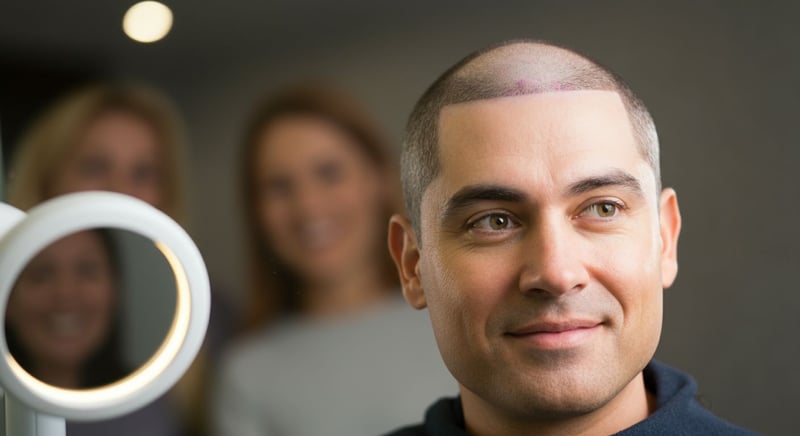Decoding Hair Restoration: A Modern Guide to Regrowth
Explore estethica's advanced hair restoration techniques to regain confidence with natural-looking results.
Hair restoration has transcended traditional methods to embrace innovative techniques that promise natural-looking results. In this modern guide, we'll explore the nuances of hair regrowth, focusing on methods offered by leading clinics such as estethica. From identifying the root causes of hair loss to examining advanced procedures like FUE and DHI, this guide aims to provide a comprehensive insight into the world of hair restoration.
Understanding Hair Loss: Identifying the Root Causes
Deciphering the Multifaceted Nature of Hair Loss
Hair loss, or alopecia, presents in various forms, each potentially stemming from a unique set of causes. Genetic predispositions, hormonal imbalances, and specific medical conditions are frequently at the forefront. However, lifestyle factors such as stress, diet, and even hair care practices also play significant roles. Accurately identifying the root cause is crucial for effective hair restoration. For example, a study published in the Journal of the American Academy of Dermatology found that nearly 80 million people in America suffer from hereditary hair loss.
Common Factors Contributing to Hair Loss
- Genetic Predisposition: Androgenetic alopecia, the most common cause, follows hereditary patterns, affecting both men and women differently.
- Hormonal Imbalances: Conditions like thyroid disorders or menopause can disrupt hormone levels, leading to temporary or permanent hair thinning.
- Medical Conditions: Autoimmune diseases, scalp infections, and other underlying health issues can directly impact hair follicle health and growth.
Recognizing these diverse factors allows a targeted approach to hair loss treatment, potentially including medication, lifestyle adjustments, or advanced procedures like a hair transplant.
estethica's Diagnostic Approach to Hair Loss
- Comprehensive Consultation: estethica begins with a detailed consultation to gather medical history and assess lifestyle factors.
- Advanced Diagnostics: Utilizing techniques such as trichoscopy, estethica experts closely examine the scalp and hair follicles to identify the precise cause of hair thinning.
- Tailored Treatment Plans: Based on the diagnostic findings, estethica creates personalized strategies encompassing medical treatments, lifestyle modifications, or surgical options.
estethica employs advanced diagnostic tools to pinpoint the underlying causes of hair loss, creating individually tailored treatment plans. This ensures that each patient receives the most effective and appropriate intervention, whether it be medical therapy, lifestyle adjustments, or considering options such as a hair transplant in Istanbul.

Hair Transplant Techniques: FUT vs. Follicular Unit Extraction Explained
Comparing FUT and FUE Hair Transplant Methodologies
The core difference between FUT (Follicular Unit Transplantation) and FUE (Follicular Unit Extraction) lies in the method of follicle harvesting. FUT, sometimes referred to as strip harvesting, involves removing a strip of scalp from the donor area, typically at the back of the head. This strip is then dissected into individual follicular units under a microscope before being implanted into the recipient area. FUE, on the other hand, involves the individual extraction of follicular units directly from the scalp using a specialized punch tool, thereby avoiding the need for a large incision. At estethica, the use of advanced techniques ensures that both methods are performed with the highest precision.
Advantages of Modern Hair Transplant Techniques
- Minimally Invasive Procedures: Advanced FUE techniques reduce trauma to the scalp.
- Natural-Looking Results: Precise follicle placement ensures aesthetic outcomes.
- Shorter Recovery Time:FUE’s less invasive nature facilitates quicker healing.
The Hair Transplant Process at estethica
- Initial Consultation: Comprehensive assessment of hair loss and scalp condition.
- Follicle Extraction: Utilizing either FUT or advanced FUE techniques, depending on patient needs.
- Careful Implantation: Skilled surgeons precisely place follicles for optimal growth and natural appearance.
estethica's approach focuses on using the most suitable technique for each individual, ensuring the best possible outcome in hair restoration, whether through FUT or FUE. For instance, the precision of the Sapphire FUE method available at estethica often results in minimal scarring and a faster recovery period.

Is Hair Transplantation Right for You? Candidacy and Expectations
Essential Criteria for Hair Transplant Candidacy
Assessing whether hair transplantation is suitable involves several key considerations. Firstly, the extent and pattern of hair loss are crucial; ideal candidates typically exhibit stable hair loss with a well-defined donor area. Secondly, the quality and density of donor hair significantly influence the potential outcome. Thirdly, overall health impacts both the procedure's safety and the subsequent hair growth. For instance, individuals with autoimmune diseases may not be ideal candidates due to potential complications. During an evaluation at estethica, doctors take a lot of factors into account such as patient’s medical data and patient’s needs by using new analyzing technologies.
Realistic Expectations and Maintenance After Hair Restoration
- Understanding Limitations: While hair transplants can significantly enhance hair density, they may not fully restore the original hairline or density.
- Commitment to Aftercare: Post-transplant care, including medication and specific hair care routines, is essential for graft survival and optimal growth.
- Potential for Future Procedures: Depending on the progression of hair loss, additional sessions may be necessary to maintain density over time.
Clinics like estethica emphasize transparent communication, ensuring patients are well-informed about both the potential benefits and the ongoing commitment required for successful long-term results. This preparation enables patients to approach hair restoration with realistic expectations and a proactive mindset.

Beyond the Procedure: Comprehensive Hair Loss Treatment Options
Exploring Non-Surgical Options for Hair Restoration
For individuals exploring alternatives to hair transplants, a range of non-surgical treatments offers promising outcomes. Platelet-rich plasma (PRP) therapy involves concentrating platelets from the patient's blood and injecting them into the scalp, fostering hair follicle stimulation and enhanced growth. Ozone therapy enhances scalp health by boosting oxygen levels in the tissues, revitalizing dormant follicles. Low-level laser therapy (LLLT) employs light energy to stimulate cellular activity in hair follicles, promoting regrowth without invasive procedures. Clinics like estethica integrate these treatments for a holistic approach to managing hair loss.
Benefits of Integrative Hair Loss Therapies
- Enhanced Follicle Strength: PRP therapy fortifies hair follicles, improving their ability to sustain growth.
- Improved Scalp Health: Ozone therapy revitalizes the scalp by increasing oxygen supply, creating a healthier environment for hair growth.
- Non-Invasive Stimulation: LLLT offers a gentle method to stimulate hair follicles using light energy, suitable for those preferring non-surgical options.
The Role of Advanced Therapies in Comprehensive Hair Management
- Personalized Treatment Selection: Therapies like PRP, ozone, and LLLT are chosen based on individual hair loss conditions and overall health.
- Synergistic Application: These treatments can be combined with or used independently of hair transplant procedures to enhance outcomes.
- Ongoing Scalp and Follicle Support: Regular therapies help maintain hair follicle health, crucial for sustainable hair growth and preventing future hair loss.
Advanced FUE and DHI Techniques for Natural-Looking Hair Restoration
Comprehensive Hair Loss Management Through Personalized Treatment Plans
Frequently Asked Questions
What are the primary causes of hair loss that can be addressed with hair loss treatment?
What is the difference between FUT and follicular unit extraction (FUE) hair transplant techniques?
Who is considered an ideal candidate for a hair transplant for receding hairline, and what are the key factors?
What non-surgical hair loss treatment options are available beyond hair transplant procedures?
How do advanced techniques like FUE and DHI contribute to natural-looking hair restoration results?
Ready to discover your personalized path to aesthetic excellence and well-being?
📞 Book Your Free Consultation!